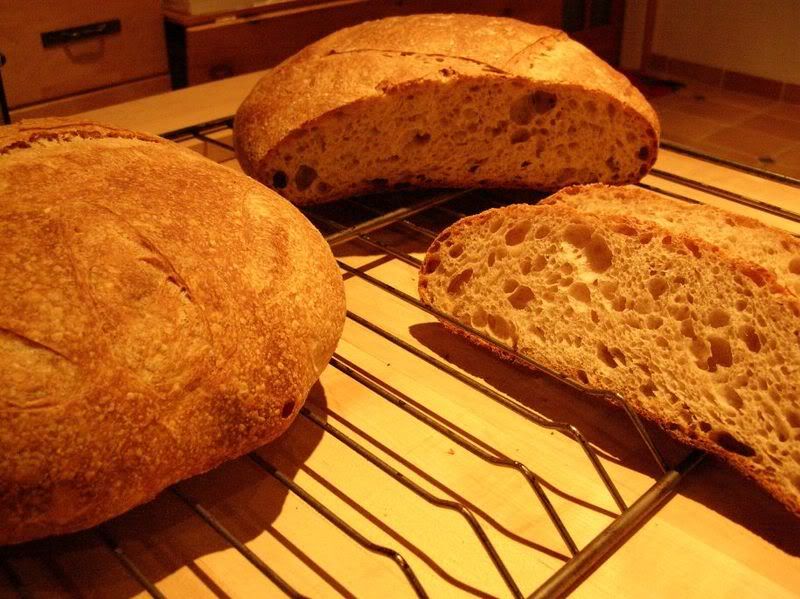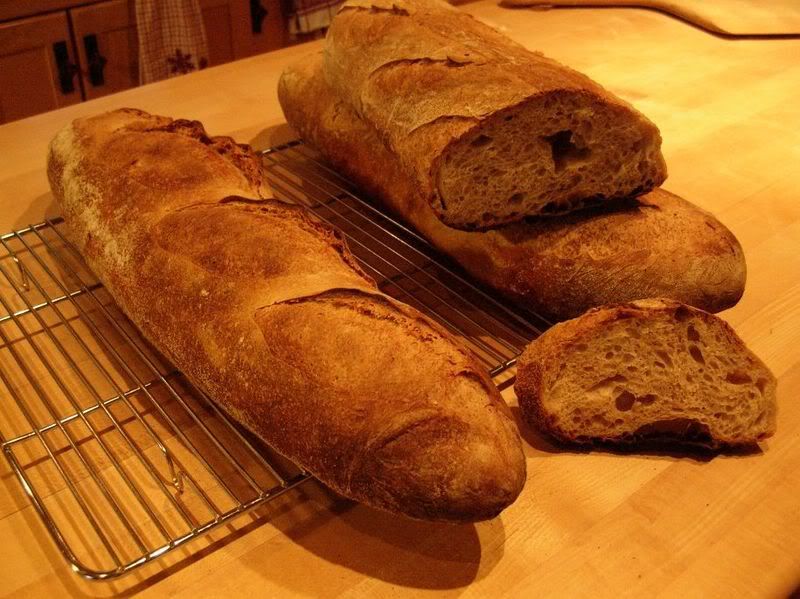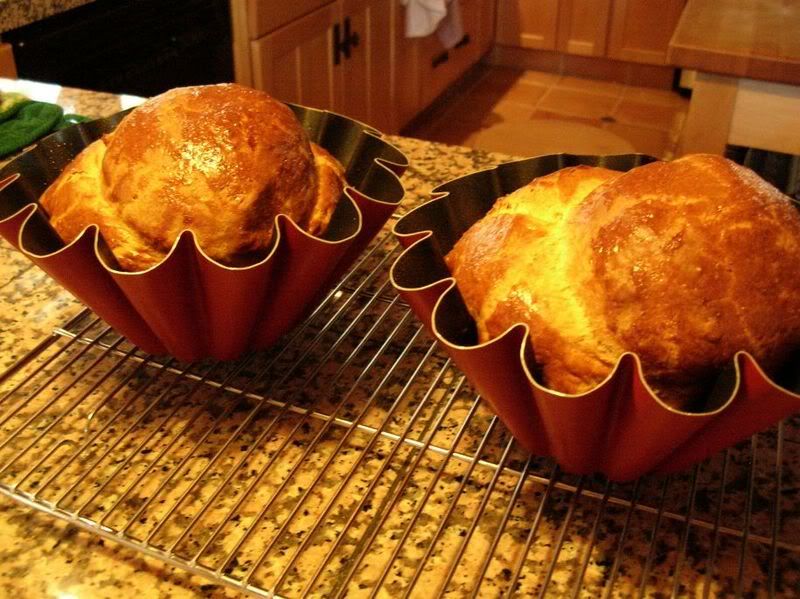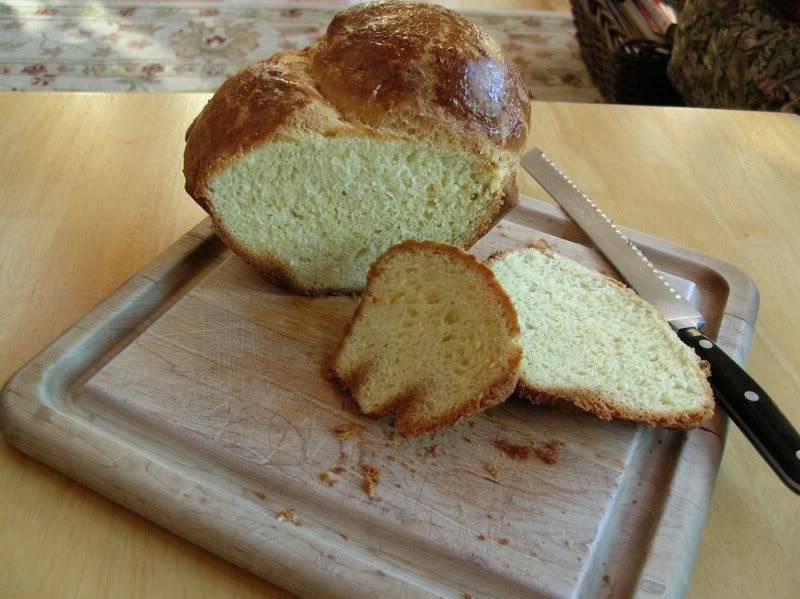It's been quite a long time since I've actively participated on this forum, but I have the flu this week and am cooped up inside with plenty of time to bake and web surf, so thought I'd provide an update on how I think I've improved on some of my old sourdough techniques, as well as show some fun results with brioche.
French Fold on Sourdough
After all these years, I still find that my favorite sourdough formulas are either the Columbia or the Thom Leonard boules from Glezer's Artisan Baking. I always return to them over again, and often make some of each in a given week, as they have some different qualities that I like in both.
I've posted the formulas for these breads here a few years ago, but I've since changed my methods a bit. For quite a long time, over a year, I abandoned my KitchenAid Pro 600 stand mixer and started using the no-knead technique as many here have used, extending the bulk fermentation to overnight at room temp, and giving 3 good stretch-and-folds the first 90 minutes into the first bulk ferment before going to bed at night. That sure made things easy, and I was able to fit it into my busy summer schedule especially, but it didn't quite give me the open and flavorful crumb I really wanted. I think the dough just wasn't getting quite developed enough via that method.
I don't think my dough hook on my stand mixer, however, was really doing such a great job developing the gluten as well, so recently I began really studying the French Fold in more detail, and I really find Richard Bertinet's video extremely helpful for this, thanks to people on this site pointing me there when I lurked earlier this Fall. To make my sourdough I now continue to do it all by hand, relatively quickly, with really superior results to what I got before using no-knead or even stand mixer.
Here's my long-ferment adaptation of the Columbia Sourdough from Maggie Glezer's Artisan Baking:
Makes two 44-ounce (1250 g) round boules or four 22-oz batards (original recipe doubled)
Time: about 36 hrs. with 20 minutes of active work
This method works well if you are busy with work during the week and don't want to be baking all day Saturday either. I begin this process on Friday Morning. Once you get comfortable with it, you could even begin it Thurs. evening and make the final dough before work on Friday morning, letting it rise while at work and shaping as soon as you get home.
Approx. 30 hours before baking (e.g. Fri. Morning) make the Levain as follows:
90 g ( 2 oz) fermented white/wheat-flour sourdough starter refreshed 8-12 hrs before (I use a batter-like starter made with equal weights water to flour, not a firm starter.)
140 g (6.6 oz) lukewarm water
320 g (10.6 oz) unbleached all-purpose or bread flour
Dissolve starter in the water, then add flour and knead this stiff dough until smooth. Place in covered container and ferment at room temp (@70F) until doubled, 8-12 hrs.
That evening (e.g. Fri. Evening) make the final dough as follows:
1200 g (42.4 oz) unbleached all-purpose flour
110 g (3.8 oz) whole-wheat flour, finely ground
30 g (1 oz) whole-rye flour, finely ground
40 g (1.4 oz) toasted wheat germ
40 g (1.4 oz) non-diastatic barley malt syrup (This is sold in most supermarkets or where home-beer-brewing supplies are sold.)
970 g (34 oz) warm water
all the fermented levain you made the night before (550 g or 23.2 oz)
32 g (1 oz) fine sea salt
Mix By hand: combine all 3 flours, wheat germ, and salt in large bowl, and mix thoroughly with rubber spatula or mixing spoon until all dry ingredients are perfectly distributed. Measure the warm water first and while it's sitting in a container on your scale, use a clean tablespoon to scoop a little syrup at a time into the water until the correct weight (40g) is added to the water. If you accidentally spoon in too much, just scoop a little syrup out of the water before it dissolves, stir well to dissolve. Pour the malted water over the ripe levain and mix well until dissolved, then pour the water/levain liquid over the flour mixture and mix with spoon, dough whisk, or hands until just combined. Cover bowl with plastic wrap and let dough rest 1 hour at room temp. (@60-70F).
So, my dough handling method now is:
1) mix all dry ingredients together in large mixing bowl: flours, salt
2) add water to the ripe levain to dissolve and mix in its own bowl
3) add watered levain to flours in large mixing bowl and mix until well-combined by hand with my trusty King Arthur dough whisk (or use spoon or hands).
4) cover bowl and let rest for 1 hour.
5) tip rested dough onto clean counter (no flour, no oil, no water) and begin the French fold a la Bertinet. I do this for at least 5 minutes before giving it a rest, scraping the dough together with a bench scraper, and continuing for another 5 minutes. It is amazing how well this works even for very wet doughs. The first minute or so, it is tough, you feel the dough tighten and not stretch yet still be sticky and you're ready to give up, but keep at it and all of the sudden, the dough starts to stretch while simultaneously becoming less sticky, you can really feel it change. By the second 5 minute stretch, it really starts to look like in the video andd tightens up really nicely, leaving almost nothing sticking to the counter.
6) After 10 min. of the French fold, place dough ball into lightly oiled container and cover, let rest 30 minutes, and then do a regular gentle stretch and letter fold after 30 minutes. Repeat this rest and stretch-fold 1 more time, then let dough bulk ferment overnight in cool location (50F-60F) until a little more than doubled in bulk.
7) Next morning, shape dough into loaves as desired and let rise until doubled again, around 4-5 hours in my chilly 60-65F house. Bake as usual.
This total 10 min. French fold develops the gluen just as well as traditional hand kneading with added flour for 15-20 min. and I think works better than my stand mixer ever did. The benefits are less time kneading, no added flour to toughen up the dough, but better gluten development, and easier to work with large batches that don't fit in my stand mixer anyhow.

The Thom Leonard boule (above) crumb from the French Fold. This was a wet dough and I had not yet studied David Snyder's scoring video when I baked these. After seeing David's scoring tips, my Comunbia batards (below) turned out with better ears, even though those were also wet doughs. (Oops, my batard shaping still needs practice as I left a "baker's cave" in there).

FYI - my adaptation of the Thom Leonard boule (also from Glezer's Artisan Baking) is the same mehod as above for Columbia, just different formula and quanitity of dough, as follows:
Makes one 4 lb. (1.8 kilo) large boule or two 2 lb boules.
Time: about 36 hrs. with 20 minutes of active work
The evening before baking make the Levain as follows:
45 g (1 oz) fermented white/wheat-flour sourdough starter refreshed 8-12 hrs before (I use a batter-like starter made with equal weights water to flour, not a firm starter. If you are using a rye-flour starter, substitute the 30 g of the rye flour in the final dough with more white AP flour.)
120 g (3.3 oz) lukewarm water
140 g (5.3 oz) unbleached all-purpose or bread flour
Dissolve starter in the water in a small bowl, then add flour and beat this batter-like dough until very smooth. Place in covered container and ferment at room temp (@70F) until doubled, 8-12 hrs.
Next day make the final dough as follows:
250 g (8.8 oz) Whole Wheat Flour (If you like your bread a little darker add up to 350 g whole wheat here and use less white flour below.)
30 g (1 oz) whole-rye flour, finely ground (If using a rye-flour starter in the levain rather than wheat, substitute the rye flour here with 30 g more white AP flour.)
850 g (29.9 oz) unbleached all-purpose flour
780 g (27.5 oz) warm water
all the fermented levain you made the night before (305 g or 10.6 oz)
23 g (0.8 oz) fine sea salt or course Celtic Grey Sea Salt
Brioches a Tete
Since my husband's family are visiting here from France this winter, I decided to make some brioche, which I have't done in a long time, using some lovely non-stick molds they brought me from France. I made Peter Reinhart's Rich Man's Brioche from the BBA, and I also used Bertinet's French Fold method to mix and knead the dough, but this dough was really too wet and full of butter to do this properly (really like a cake batter), still, I persisted, and it eventually did come together a bit, and turned out nice and light, despite having a fine-textured crumb. I think next time I will try Peter's middle-class brioche, which has about half the butter. This version here was heavenly with a good cup of coffee on a cold snowy winter morning though :-)


- mountaindog's Blog
- Log in or register to post comments
Well Howdy! You've been missed!
Er, as have I, perhaps, as I've not been so active either. I still bake all the time, I just feel like I pretty much bake the same 5 or 6 loaves over and over, and I've gotten my technique to a place where I feel comfy with it.
Anyway, beautiful loaves, as always. I may have to make that Colombia recipe sometime very, very soon ....
Great to hear from old friends! How's life in Oregon (must be great!)? I'm sure life has been busy for you since you've moved there, and yes, it is amazing how you get into a comfort level with some bread recipes where they just become part of routine life, which is a good thing compared to having to buy store-bought bread all the time.
Nice to see how this site has evolved thanks to Floyd's diligence, and of course there is always so much to learn from the amazing bakers who come here to share their ideas. The whole home-milling thing is really fascinating and something I could dangerously get swallowed up in if I'm not careful, and I just don't have time, so I'll continue to read of other's experiences in that area and stick to my store-bought flours for now...Otherwise I'd never have time to show up for work or maintain my vegetable garden :-) Great to hear from you, Iris must be getting big!
Really good to see you again. I'll be pleased to read your post when I have some time, busy today unfortunately. You were missed!
Eric
Eric - great to see your friendly presence all over TFL again! You have kept active here and seem to have done so many things since I've last checked in, where shall I start reading and catching up first? Did I read correctly somewhere that you, the master of eye-opening no-knead techniques, are using DLX mixer now!? :-) Please do tell me what I need to know about this...looking forward to catching up soon!
Hi, Mountaindog.
All 3 breads look great.
I wonder if anyone on TFL is still doing traditional hand kneading for lean breads. For slack doughs (>75% hydration), I've been stretching and folding the dough in a bowl with good success. With firmer doughs, I've had problems with the French Fold technique. The dough gets too elastic too fast, and it doesn't really want to stretch. If I force the issue, it tends to tear. Any tips?
David
Hi David - if I am not mistaken my version of the Columbia is between 66-68% hydration (counting the water/flour in the levain), so not as wet as what you might conisder slack at 75% hydration, but I was able to do the French fold no problem. As soon as it begins to get real tight and tear, as you mention, just let it rest on the bench for about a minute or two, then continue again and you should be able to go a few more minutes I think, at least that's been my experience. In the very first 1-3 minutes of French-folding, it got real tight yet still gloppy at the same time (hard to explain, like I was not able to get it to stretch at all and flip over) and that's when you think this is just not working, then all of a sudden it stretches out, so that's when you have to keep at it. Sounds like you might be referring to the real tightening up near the middle or end though, and that is when the bench rest works. Of course everything may be predicated by all of those unique types of flours you are using and the difference in how much they absorb water comparted to my run-of-the-mill (no pun intended) KA AP flour. :-)
That's really helpful.
The stretching and folding in the bowl technique I use involves the equivalent of about 2-3 minutes mixing with 20 minutes rest between each mixing.
I've not used short bursts of French Folding with rests in between, but I want to give it a try.
David
Yes, it's a little hard to catch in Bertinet's video, but I'm pretty sure he lets it rest intermittently after scraping the excess dough together off the table each time, so that's where I figure the bench rests must help when it gets too tight.
Mountaindog,
Thank you for your observation about the dough consistency. I have experienced the same thing several times recently and was beginning to wonder what I was doing wrong. I'll try some rest intervals the next time around, along with a longer application of the French fold. That might address the problem I've been seeing. It seems to be more pronounced in doughs with higher percentages of whole grain flours, but I'm not ready to make any definitive statements about that, yet.
Paul
Hey MtDog
I'm glad your back although you don't need to get the flu to post. Hope your feeling better. Your bread looks fantastic. I have been using the no knead, add everything at once overnight method for a while now and love the taste and the time it gives me. Question to you is how do you feel the bread compares tastewise vs the long method? I am trying your method of Frfolding 10 min. to develope the gluten more before it's long rest and see if I can't get a more open crumb like yours. Thanks for sharing your techniques and the writeup.
Da Crumb Bum
Hey Crumb Bum! I know, I should have kept in better touch this past year, but I just find it so hard to find time to get on the computer at home after work these days. Like many, I work on a computer all day, so when I get home, I don't even want to look at one, I just want to walk my dogs, garden, read, and sleep! I think what's changed more for me since 2 years ago is the larger chunk of my time now spent on garden and property upkeep, which is most of the year round except the coldest part of winter (i.e. now).
Your miche recipe is one I need to find here, I see others rave about it so I need to catch up on my TFL reading!
As to your question on flavor and crumb structure, here's what I found: the no-knead (with only 3 stretch/folds the first 90 min. into it) was realy easy as you say, and produced better results than probably any bread I could buy from a store, but it wasn't giving me a chewy or crusty enough result as what I got from traditional kneading, so that's why I experimented both with the stand mixer again and then the French fold, which worked better then the mixer for me. I still do the long overnight ferment, I just do it at colder temps to extend the time, that way I still get the flavor. I do think the French fold and even the stand mixer gave me a more open crumb that was more irregular and had that shiny, chewier texture, like in both David's and Eric's miches they just baked here. Along with that shinier crumb, I perceived an improved flavor as well, more like the dough had a nicer roasted taste to it if that makes sense.
You may be able to see a difference in the crumb between my no-knead version of the Leonard (below) and my french fold version pictured above. My no-knead produced a much softer, finer crumb with a thinner crust, more like sandwich bread, while the French fold produced a chewier (not tough) crumb and thicker crisper crust, which we prefer. The no-knead is a great fall-back if you are short on time, though! Maybe also I was not letting the no-knead fermert long enough or something, since I think even David Snyder still does only a few stretch and folds with a long ferment yet he seems to get that shinier, chewier, crustier result that I like. Any suggestions?
Mountaindog,
I'd like to reverse the retard so that I can bake in the morning. I've got a perfect "cold room" where it'll stay between 45 and 55 degrees overnight. But I'm wondering how much time to allow for the bulk rise, if it's at room temp. I'm thinking about 5-6 hours, since 20% of the flour is in the starter, but wanted to check with you first.
Thanks!
--
JMonkey
JMonkey - So you want a shorter bulk ferment, shape, then an overnight cold proofing so you can bake first thing next morning, right? Hard to say for part 1, it depends on how much time you have and what temp you place it at, everyone has a different definition of room temp! If you mean about 70F, it will probably double in 3-4 hours for part 1, depending on on how fast your starter works (mine is rather slow it seems, even at warmer temps, thats why I let the bulk ferment go overnight).
You wouldn't believe how cold we keep our house these days, the thermostat's set at about 58-60 (but we have wood stove going so the main living section stays toasty), so my overnight bulk ferment is a long one because I want to get a good night's sleep but don't want it quite as cold as in fridge when I go to shape. What I actually do is hunt around for a 50-55F-ish location wiith my instant read thermometer (on the kitchen floor next to my mudroom door is just right) and I let the dough buckets sit there overnight, probably about 8 hours but no more than 10 hours (otherwise the lid would get blown off the bucket). The dough should double but not much more than that.
Next morning when I shape, the dough is chilly but not really cold, and after I shape it, the cold gets redistributed, so the final proof takes about another 4-5 hours at 65F in my kitchen, maybe 4 hours if I place the bannetons near my woodstove at 70 F, I just let it go until it looks right, do other Saturday chores, and bake in the afternoon. Of course spring, summer, and fall are entirely different matters for time and temp, but even then I can usually find a cool spot at night for a 55-ish bulk ferment that allows me to sleep 8 hours (unless it's a summer heat wave, then forget it).
Hope that helps...I'm trying to get my starter more active as we speak by feeding it only with WW flour this week to see if it will rise faster, so many others here seem to get their fermenting done in much shorter time spans than I do at "room temp".
I've got the starter ripening now (jeez, you weren't kidding -- this starter is STIFF), so I'll make the dough up around 5pm, head out to play GO, get back around 9:30pm and shape (it's a little cooler than 70 degrees ... more like 65 or so). I get up at 5am, so, hopefully, it'll be ready to pop into a hot oven (I'll set my oven to start pre-heating at 5am.)
With luck, I'll be able to make sandwiches for my wife and daughter's lunches at 7am. Woo!
Your breads look lovely! Very interesting post with great explanations. And now that I have actually USED American flours, I can now fully understand the descriptions you give and David's questions. It's another example of how the different flours just do not act the same. I really like what I call "the slap and fold" Bertinet method of kneading, but if the dough is really high hydration, I go for the no-knead Hamelman technique. I haven't noticed a difference in the crumb with French flours.
I can't seem to find the time to post my Bread flour baguette results, but I will do my best to show them before the end of the week.
Hope you're feeling better,
Jane
Merci Jane! I look forward to your baguette results.
J'aime beaucoup votre blog Au Levain, surout votre blog de cuisine de famille, et le Gigot d'agneau! Mais j'ai lu en français puis-je mieux parler ou écrire.
So good to see you back! Gosh..maybe I should get the flu so I can post such an informative piece as you did!! Have to admit, a bit tired tonight. I get up at 3AM, but I am going to come back and read your change from KA to french fold. Thom Leonard has become our family's standard. Hope you are feeling better by now!
Betty
Hi Betty, nice to see you still here and glad you like the TL recipe still. Yes, being sick is a little of a luxury in having alot of down time to read and research, but I'll be happy to get back to normal life soon I hope. Thanks for checking in!